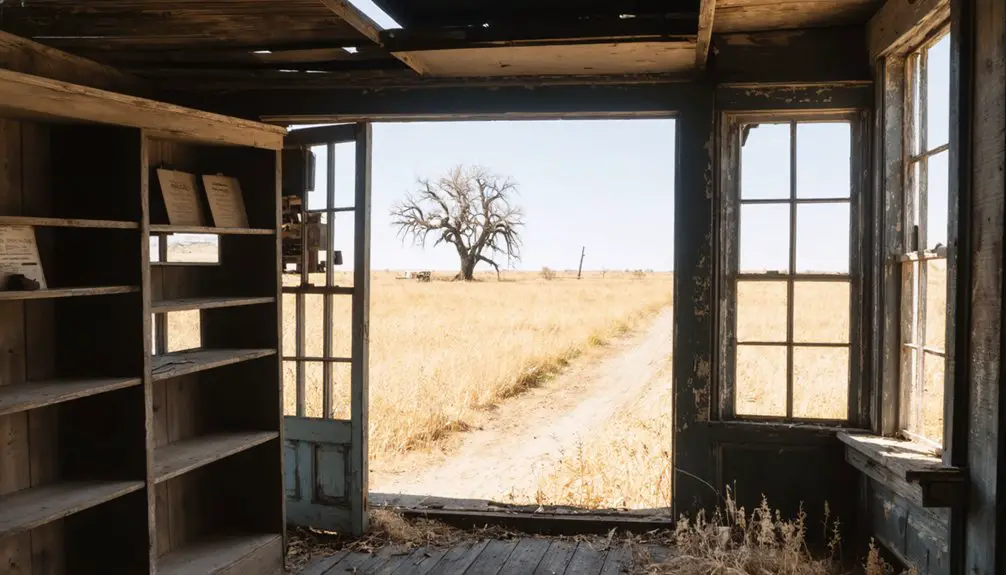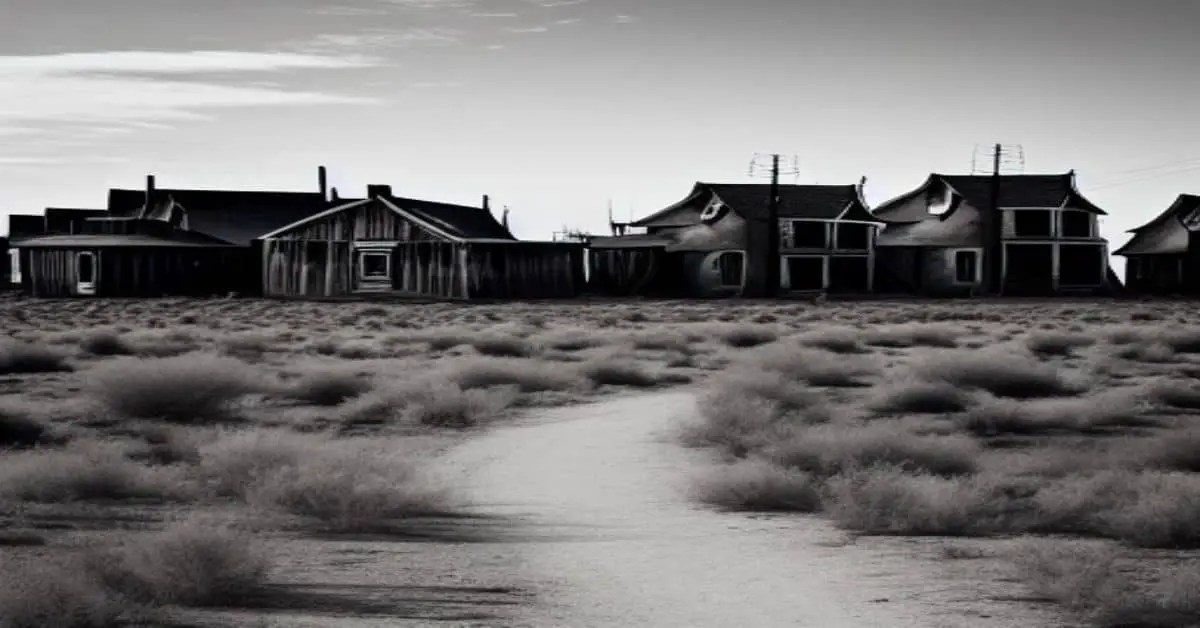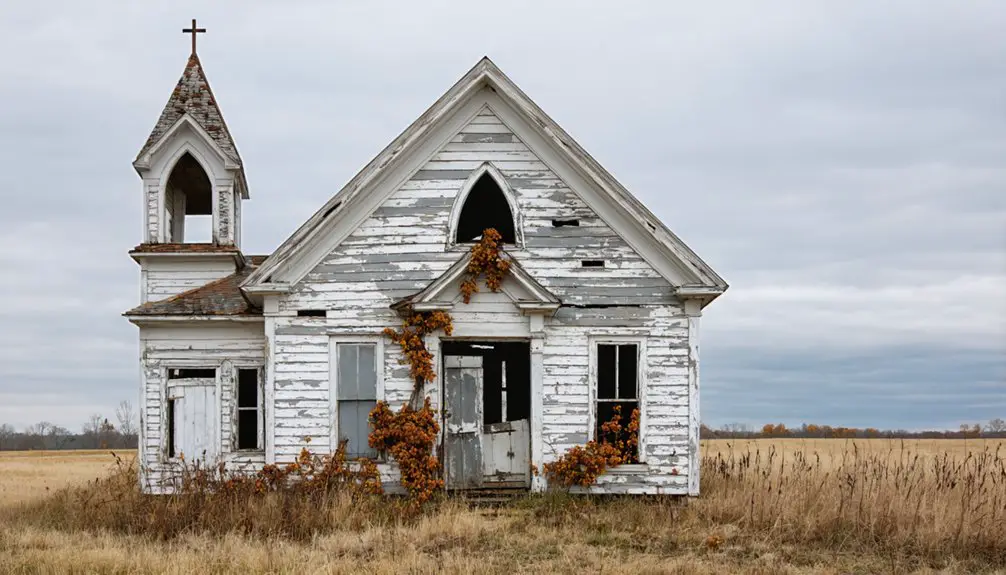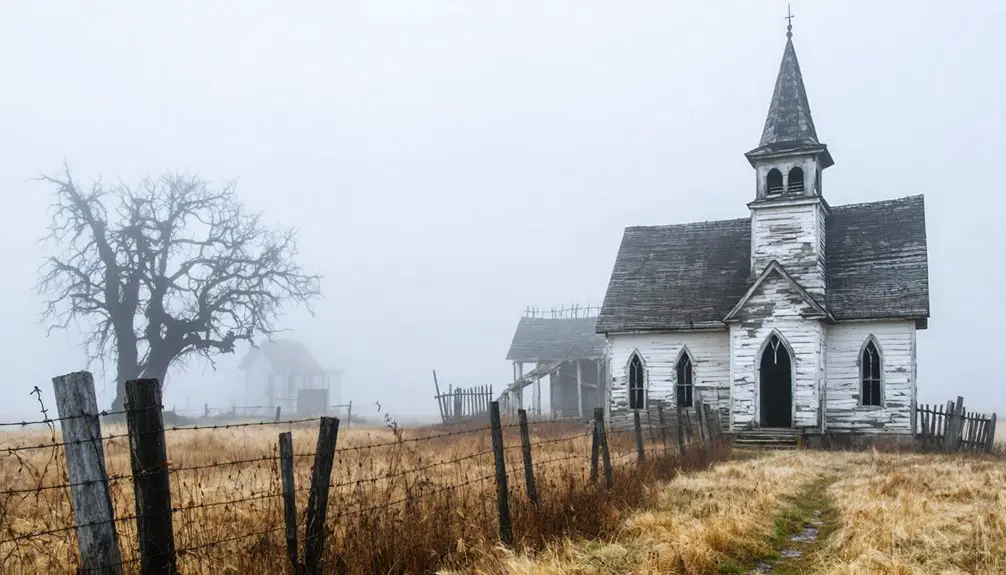You’ll find Hopewell nestled in Mississippi County’s rich floodplain, where ancient Native Americans first recognized its potential. The 15-acre Aker site marks the region’s only known Kansas City Hopewell village, featuring elaborate mortuary mounds and geometric earthworks. Later settlers transformed the wilderness into farmland, but agricultural mechanization, floods, and urban competition led to its abandonment. Today, secondary forests and wetlands have reclaimed this ghost town, though its archaeological treasures still whisper stories of the past.
Key Takeaways
- Hopewell was a farming settlement in Mississippi County’s floodplain that declined due to agricultural mechanization and economic challenges.
- The town featured the 15-acre Aker site, the region’s only known Kansas City Hopewell village with significant archaeological remains.
- Natural disasters, particularly floods, damaged local infrastructure beyond repair, contributing to the community’s abandonment.
- Transportation changes isolated the settlement as major routes bypassed the area, leading residents to seek opportunities elsewhere.
- The ghost town has largely returned to nature, with secondary growth forests and wetlands replacing former farmland and structures.
Early Settlement and Community Origins
While many Mississippi County settlements sprouted up along the mighty Mississippi River in the early 1800s, Hopewell emerged as a distinctive farming community within the fertile floodplain region.
Pioneer motivations centered on the rich soil’s promise, drawing settlers from eastern states who sought to carve out their own destiny in Missouri’s frontier. You’ll find that these early homesteaders quickly established agricultural practices suited to the region’s unique climate and terrain. Like other lost towns of Missouri, Hopewell’s story illustrates dramatic changes in community life over time. The geographic disambiguation helps distinguish this settlement from numerous other Hopewell locations across America.
Early settlers journeyed westward to Missouri’s rich frontier lands, transforming untamed wilderness into thriving farms through determination and agricultural innovation.
As families put down roots, they built simple wood-frame structures and forged informal networks for trade and mutual support.
The community’s lifeblood flowed through seasonal farming rhythms, while the nearby river provided additional opportunities for commerce and sustenance. A shared pioneer spirit bound these settlers together as they transformed the wilderness into productive farmland.
Decline and Abandonment Factors
The promising agricultural settlement of Hopewell would face mounting challenges that ultimately sealed its fate as a ghost town.
Like many rural communities in Missouri’s heartland, Hopewell couldn’t withstand the perfect storm of societal pressures and economic decline that swept through the region. The Great Depression in 1929 hit the area particularly hard, mirroring the devastation that affected other Missouri farming communities.
Here’s what led to Hopewell’s downfall:
- Agricultural mechanization drastically reduced the need for farm labor, forcing families to seek work elsewhere.
- Transportation changes left the town isolated when major routes bypassed the community.
- Natural disasters, including devastating floods, damaged local infrastructure beyond repair.
- Growing urban competition from nearby cities drew away residents with better opportunities.
Economic depressions further accelerated the town’s decline, making it increasingly difficult for remaining businesses to stay afloat.
You’ll find that Hopewell’s story mirrors countless other ghost towns across Missouri, where the combined forces of progress and adversity transformed once-thriving communities into mere memories.
Geographic and Environmental Features
Nestled within Mississippi County’s rich floodplain, Hopewell occupied a distinctive ecological niche along Missouri’s eastern border with the mighty Mississippi River.
Along Missouri’s eastern edge, Hopewell thrived in Mississippi County’s fertile floodplain, where river waters shaped the land.
You’ll find this ghost town’s former site characterized by floodplain dynamics that shaped both the natural landscape and human settlement patterns. The terrain’s low-lying nature, coupled with exceptional soil fertility from centuries of river deposits, created ideal conditions for farming despite the ever-present flood risks. Like the ancient trade networks that once connected regions across North America, the river served as a vital transportation corridor.
Similar to the nearby Aker village site, this location’s position on the Mississippi River floodplain made it a prime area for settlement.
The area’s humid subtropical climate brings you hot summers and mild winters, with annual rainfall averaging 40-45 inches.
Oak-hickory forests once dominated the landscape, interrupted by wetlands and natural levees formed by the river’s meandering path.
Today, the abandoned settlement has largely returned to nature, with secondary growth forests and wetland vegetation reclaiming what was once cultivated land.
Historical Landmarks and Structures
Amid Hopewell’s natural setting, you’ll find remarkable archaeological treasures that tell a deeper story of ancient human settlement. The area’s ceremonial earthworks and architectural remnants showcase the sophistication of Hopewell culture, particularly near the Missouri River’s floodplains. Much like the portable houses by rail that were brought in for timber workers in Horton’s early days, these structures represent essential community accommodations. Similar to the Santa Fe Depot ruins still visible in Medill, these historical sites capture a moment frozen in time.
You can explore these fascinating historical landmarks:
- The 15-acre Aker site, representing the region’s only known Kansas City Hopewell village
- Elaborate mortuary mounds lined with precious mica sheets and woven mats
- Geometric earthworks that served as sacred ceremonial grounds
- Village remnants near Line Creek, featuring evidence of complex community structures
The Hopewell architecture reflects a society that masterfully balanced daily life with spiritual practices.
These sites preserve the legacy of a people who crafted intricate burial chambers and community spaces, leaving behind a testament to their remarkable engineering skills.
Legacy in Mississippi County Today
While modern-day visitors to Mississippi County might overlook Hopewell’s quiet presence, this ghost town‘s legacy persists through historical records and geographical markers in northeastern Ohio Township.
Hidden from modern eyes, Hopewell’s ghostly footprint endures in maps and memories across Ohio Township’s northeastern reaches.
You’ll find its historical significance woven into local educational materials and planning documents, though physical remnants are scarce.
The town’s cultural memory lives on through historical societies and researchers who study it as an example of 19th-century settlement patterns and rural decline.
In today’s Mississippi County, Hopewell’s story enriches our understanding of regional development and demographic shifts.
While the land remains largely undeveloped, the ghost town’s existence continues to inform discussions about community lifecycles and local heritage, making it a valuable piece of the county’s historical narrative.
Frequently Asked Questions
Are There Any Surviving Photographs of Hopewell During Its Active Period?
You won’t find any surviving historical documentation or photographic evidence from Hopewell’s active years. Despite efforts to locate pictures through archives and local collections, there’s nothing concrete that’s been discovered.
What Native Tribes Originally Inhabited the Area Before Hopewell’s Establishment?
You’ll find that the powerful Osage people dominated this region’s Indigenous history, though the area earlier saw Missouri tribes like the Missouria passing through before European settlement forced their westward migration.
Were Any Notable Crimes or Mysterious Events Reported in Hopewell?
You won’t find any documented unsolved mysteries or historical crimes here – the records are pretty quiet. While other Missouri ghost towns have their dark tales, Hopewell’s kept its secrets clean.
Did Hopewell Have Its Own School System or Church Communities?
You won’t find direct records of Hopewell education or religion facilities, though like many rural Missouri communities, they likely had informal church meetings and subscription-based schooling before eventual consolidation.
Are There Any Living Descendants of Original Hopewell Residents Still Nearby?
You’ll find family connections scattered across nearby communities, but it’s hard to confirm direct descendants. Local history suggests some folks with ancestral ties might live in surrounding Mississippi County towns.
References
- https://kids.kiddle.co/List_of_ghost_towns_in_Missouri
- https://en.wikipedia.org/wiki/List_of_ghost_towns_in_Missouri
- https://en.wikipedia.org/wiki/Hopewell
- https://kids.kiddle.co/Hopewell
- https://www.youtube.com/watch?v=3ElM_xAtbAY
- https://legendsofkansas.com/kansas-ghost-town-list/
- https://www.thesalemnewsonline.com/dent_county_life/article_52699550-8371-11ea-bc6d-cf5f28e4259c.html
- https://jimhinckleysamerica.com/2010/06/03/day-five-the-route-66-adventure-on-the-ghost-town-trail-in-missouri/
- https://biodiversity.ku.edu/archaeology/collections/highlights/plains/hopewell
- https://en.wikipedia.org/wiki/Hopewell_tradition



